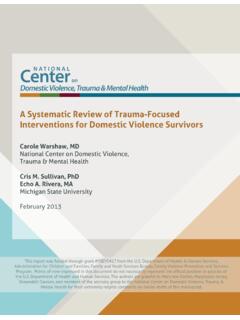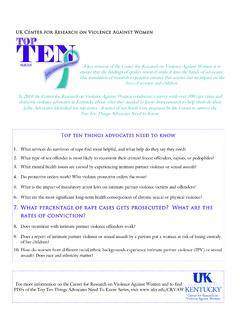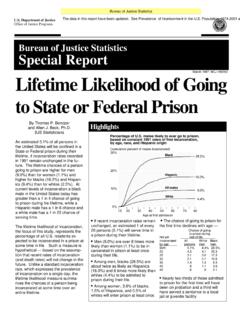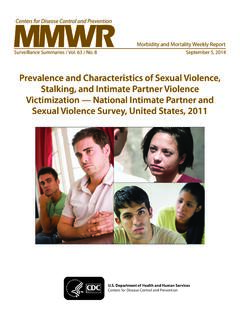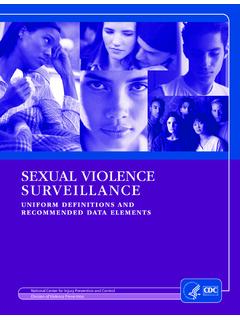Transcription of Prisons and Health, 4 Violence, sexual abuse and torture ...
1 194. Violence, sexual abuse and torture in Prisons Jens ModvigKey points Violence in Prisons is often clandestine because of the fear of reprisal when it is reported. Because violence is not brought into the open, it is easily overlooked or underestimated. Authorities are obliged to protect prisoners against violence, which must not constitute an additional punishment on top of deprivation of liberty. Violence begets violence, so prison violence inhibits rehabilitation for normal life. Violence occurs mostly in high-security facilities and Prisons with coercive practices, even though the security measures have been established to minimize the violence. A key performance indicator for the prevention of violence is that prisoners feel safe and secure. About 25% of prisoners are victimized by violence each year while 4 5% experience sexual violence and 1 2% are raped.
2 Prevention may focus on the prisoners by identifying groups with special needs who are at risk of being victimized. Prevention may focus on creating a positive prison climate to encourage respect, humanity and are violent places compared to the community. United States government statistics demonstrate that rates of physical assault for male inmates are more than 18 times higher than the equivalent rates for males in the general population. For female inmates, the rates are more than 27 times higher (1).Violence in Prisons is and should be a prison management and prison health service priority issue for several reasons. First, violence begets violence, that is, exposure to violence during adolescence increases the risk of later violent and non-violent crime, drug use and intimate violence against or from a partner (2). Thus, the rehabilitation or corrective dimension of imprisonment is undermined if prisoners are placed in an environment that makes them more violent and more criminal than , in international law, prisoners are entitled to protection against violence such as assault, rape and torture .
3 According to principle 5 of the United Nations Basic Principles for the Treatment of Prisoners: Except for those limitations that are demonstrably necessitated by the fact of incarceration, all prisoners shall retain the human rights and fundamental freedoms set out in the Universal Declaration of Human Rights .. (3).Thus, state authorities have an obligation to ensure that prisoners enjoy protection against all human rights , a violent institution is more difficult and expensive to manage than a secure and safe institution with a positive climate, including a positive working is difficult to address and assess precisely because it is surrounded by silence and, therefore, often underreported. Violence is except for a justified proportionate use of force by staff illegal and punishable. For this reason, reporting of violence committed by prisoners or by staff may lead to reprisals and retaliation ( snitches get stitches ).
4 While this may also be the case in the world outside the prison, the deprivation of liberty means that a victim who reports the violence has no possibility of escape from the retaliation by the perpetrator. A study found that 25% of respondents who had not reported their most recent experiences of assault said that they did not believe that reporting victimization would make a difference. An additional 20% did not report an assault because they feared retaliation (4). Comparisons of official violence and disorder statistics with unofficial statistics indeed reveal that the official statistics underestimate the problems (5).Definitions of violence in prisonWHO has defined violence as The intentional use of physical force or power, threatened or actual, against oneself, another person, or against a group or community, that either results in or has a high likelihood of resulting in injury, death, psychological harm, maldevelopment or deprivation (6).
5 It is noteworthy that the definition includes threats such as the potential use of force, and that the defining outcome is not only injury or death but also psychological harm, maldevelopment and may further be categorized as self-directed, interpersonal or collective when directed towards: (i) oneself; (ii) one s family, intimate partner or unrelated person; and (iii) specifically defined groups for reasons of 20 Prisons and healtha social, political or economic agenda. Organized groups or states may perpetrate collective violence. The nature of the violence may be physical, psychological, sexual or deprivation/neglect (7).In a prison context, the prison authorities have a general obligation to protect inmates against any type of violence, including excessive use of force. This chapter will address how prison authorities, including prison health services, may address the issue of for a proportionate use of force required for security procedures (which is outside the scope of this chapter), the many types of violence that may occur in Prisons include: suicides, suicide attempts and self-harm; physical violence (beatings, fights) among prisoners; psychological violence such as threats, bullying or humiliation; sexual assaults of prisoners by other prisoners or by prison staff; excessive violence committed by prison staff towards prisoners amounting to torture or ill-treatment; violence by prisoners against prison staff, from single events to prison attempts and self-harm are outside the scope of this chapter.
6 The following discussion will deal with violence more generally between prisoners, between prisoners and staff, sexual violence, torture and ill-treatment. The occurrence of the violence and underlying risk factors will be addressed and the final section will discuss the prevention of prison violence, both among inmates and perpetrated by prison a technical note, the measures of violence used in the studies reviewed include the proportion of all prisoners exposed to violence, whether victimized once or several times (sometimes called the prevalence rate). This measure reflects the proportion of all prisoners surveyed as to their exposure to violence in the period of interest. This might be their lifetime prevalence or those who were exposed during a current or recent period of incarceration, for example, in the previous 6 or 12 studies of violence in Prisons do not have uniform measures of frequency, although United States studies tend to focus on the most recent six months.
7 In some studies, the reference period is not explicit. The differences between the estimates may be rather small, especially if the average period in prison was between 6 and 12 months, exposed prisoners were typically exposed more than once, and the prisoner had been in prison only once or twice in prisonsPrisoner-on-prisoner A recent study found a six-month male prevalence rate of 205 per 1000 for prisoner-on-prisoner physical violence and 246 per 1000 for staff-on-inmate physical violence (1). In other words, 20% of the prisoners had been subjected to physical violence by other prisoners and 25% to violence by prison staff during the preceding six months. For females, the prisoner-on-prisoner rate was the same whereas the staff-on-prisoner rate was 8%, that is, male prisoners experience more staff-on-inmate violence than female prisoners to medium-sized facilities had higher prevalence rates of inmate-on-inmate physical violence, whereas medium-sized and large facilities had higher staff-on-inmate rates of physical violence.
8 For comparison, the six-month sexual violence victimization rates for both sexes were 42 per 1000 for any sexual victimization and 15 for non-consensual sexual acts (8).Fairly consistent with the American study, a recent Australian study reported that 34% of the male inmates and 24% of the female inmates reported having been physically assaulted at any time during their imprisonment, and 7% of both genders had been threatened with sexual assault (9).Juveniles seem to be involved in prison misconduct and violence more frequently than slightly older prisoners and even more than adults (10).Prisoner-on-staffObviously, violence in Prisons makes Prisons a violent workplace for the staff. A study of direct, injury-producing violence using workers compensation claims in a random sample of 807 correctional officers in an urban prison revealed that reported one episode and reported two or more violent episodes during an average length of employment of approximately 10 years (11).
9 Thus, at least half of the prison staff suffered injury due to violence during a 10-year employment period. The main risk factors for male employees being exposed to workplace violence were long-term substance- abuse , whereas female employees seem to have a violence-reducing effect on the inmate (12) found that more than 70% of the violence against staff occurred in the detention/high security areas, during the day shift, predominantly directed towards trainees with little experience and committed by young inmates aged 25 years or violence in prisonsSexual violence is particularly difficult to study and assess 21 Violence, sexual abuse and torture in prisonsbecause of the stigma associated with being raped or abused and also because of the risk of reprisals from the perpetrator. sexual violence may be defined as behaviour that leads a person to feel that he/she is the target of aggressive intentions (13).
10 This may also include sexual pressure. In a recent study, sexual victimization was viewed more narrowly as non-consensual sexual acts with oral, vaginal or anal penetration as well as abusive sexual contacts (touching or grabbing in a sexually threatening manner or touching genitals) (14).Estimates of sexual assault victimization have varied between 1% and 41%, depending on what was included. The annual rate in United States Prisons seems to converge at about 5% or less (14). A thorough review and meta-analysis of studies of prison rape proper concluded that of inmates have experienced a completed episode of sexual victimization during their entire period(s) of incarceration (15). Recently, Wolff & Shi (14) found that 4% of male inmates and 22% of female inmates reported that they had been subject to prisoner-on-prisoner sexual victimization (most often abusive sexual contact such as inappropriate touching) during the previous six months.











